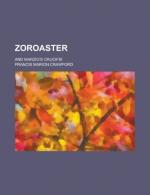Marzio Pandolfi’s intelligence lacked logic. In its place he possessed furious enthusiasm, an exaggerated estimate of the value of his social doctrines, and a whole vocabulary of terms by which to describe the ideal state after which he hankered. But though he did not possess a logic of his own, his life was itself the logical result of the circumstances he had created. As, in the diagram called the parallelogram of forces, various conflicting powers are seen to act at a point, producing an inevitable resultant in a fixed line, so in the plan of Marzio’s life, a number of different tendencies all acted at a centre, in his overstrained intelligence, and continued to push him in a direction he had not expected to follow, and of which even now he was far from suspecting the ultimate termination.
He had never loved his brother, but he had loved his wife with all his heart. He had begun to love Lucia when she was a child. He had felt a sort of admiring fondness for Gianbattista Bordogni, and a decided pride in the progress and the talent of the apprentice. By degrees, as the prime mover, his hatred for Paolo, gained force, it had absorbed his affection for Maria Luisa, who, after eighteen years of irreproachable wifehood, seemed to Marzio to be nothing better than an accomplice and a spy of his brother’s in the domestic warfare. Next, the lingering love for his child had been eaten up in the same way, and Marzio said to himself that the girl had joined the enemy, and was no longer worthy of his confidence. Lastly, the change in Gianbattista’s character and ideas seemed to destroy the last link which bound the chiseller to his family. Henceforth, his hand was against each one of his household, and he fancied that they were all banded together against himself.




